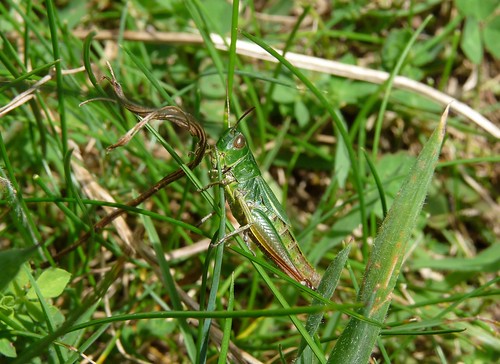As you may have noticed from the majority of my posts on this site, my main interest is in birds. However, I am just as interested in other forms of wildlife, it’s just that quite often it is a lot more difficult to photograph. Over the last few weeks during walks out on Gower, I have come across numerous examples of possibly my favourite insect, the Grasshopper. Prior to writing this post I had assumed that one Grasshopper was the same as any other Grasshopper, so was surprised to discover that there are in fact eleven different species in the UK. How many of these are found on the Gower peninsular I am not sure, but I have examples of the first two species already in the bag.
This first photo shows a female Meadow Grasshopper, photographed in long grass just above the edge of the beach at Overton Mere. “Meadow grasshoppers usually have very short wings, the visible forewings normally being a quarter to three-quarters the length of the abdomen, which makes the grasshopper unable to fly. Long winged individuals capable of flight do occur sporadically, especially in hot summers and can be difficult to tell from other species of grasshopper. The colour is variable, usually some shade of green but often brown while females can even be a plum or purple colour. Its song is a burst of 10-15 irregular chirrups, lasting a few seconds, repeated at intervals. This is a grasshopper mainly of long grass. Eggs are laid in summer in the soil, hatching the following April, becoming adult in late June and surviving usually until about October, depending on the weather.”[1]
This second photo shows a male Common Green Grasshopper, photographed in the slightly damper grass at the base of Rhossili Down. “The common green grasshopper is usually all or predominantly green but may have brown sides. Its song consists of long ‘churrs’ starting quietly and getting louder and lasting between 10 and 20 seconds. This is a species of longish grass, although it will occur in shorter, though not close-cropped turf, if the soils are moist enough. It is generally common over the whole of Britain. This is our earliest grasshopper to appear. The adult is present in June but survives no later than September. Eggs are laid in summer in the soil, hatching the following April.”[2]





0 Comments